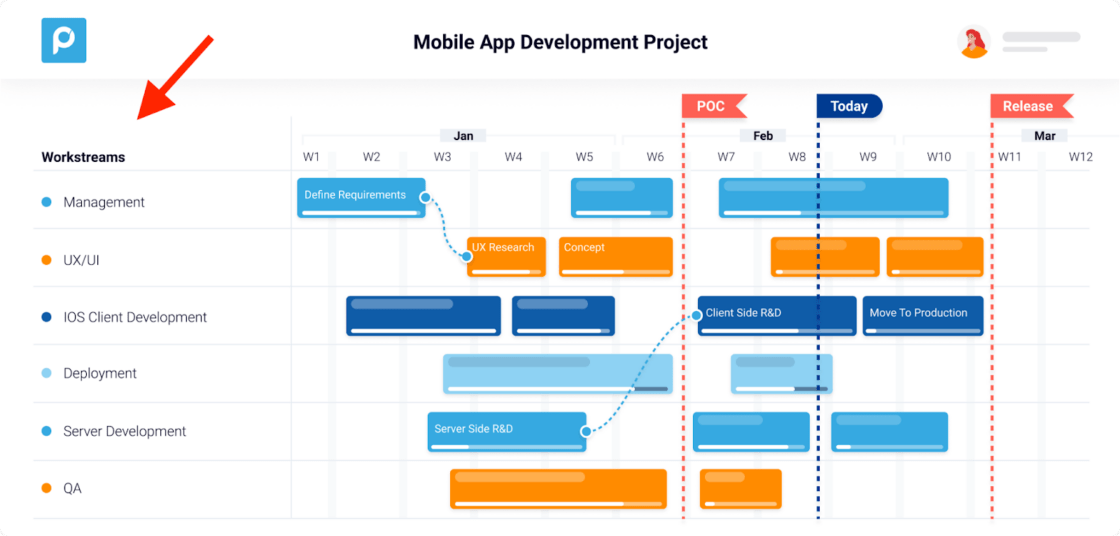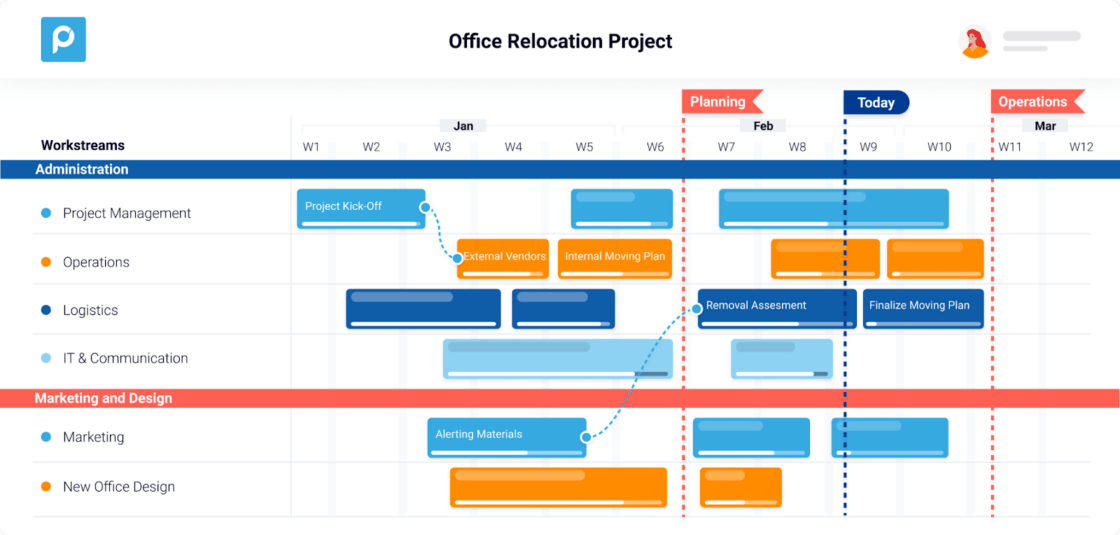The Power of Workstreams-Based Timeline

Project managers understand the need for coordination more than almost anyone. They’re constantly juggling multiple projects, managing moving parts, and scheduling cross-team collaborations.
That’s why Proggio uses Workstreams — lanes of activities within your project that be coordinated however you need, such as by department (i.e. IT or Marketing) or activity (i.e. Testing or Deployment). Basically, Workstreams reflect the way people think about projects visually. Not as complex tables, crowded graphs, or endless lists of tasks — but as seamlessly customizable streams of work that adapt to your needs and changes.
Project managers understand this need for order more than almost anyone. That’s why Proggio created Workstreams, (or project areas) — lanes of activities within your project that be organized however you need, such as by department (i.e. IT or Marketing) or activity (i.e. Testing or Deployment). Think of it as a table of contents.

To make this even simpler, let’s take the bookshelf analogy. Just as you might coordinate a bookshelf by certain categories like genre, author, title, or even color, you can use Workstreams to visualize projects in a way that helps make your life easier and more efficient.
Here’s how:
How to Select and Structure Workstreams in Proggio
Selecting the right Workstreams is essential to building a solid project plan. It lays the groundwork for a clear, organized timeline and helps surface cross-team dependencies early. When Workstreams are well-defined, they provide structure, clarify ownership, and make it easier to coordinate efforts across teams, reducing confusion and delays as the project progresses.
Before you start setting up Workstreams in Proggio, it’s helpful to think of your project layout like organizing a bookshelf. Imagine you’re arranging books by genre — fiction, non-fiction, biographies, and so on. This method makes it easy to locate specific types of content, right?
Similarly, in Proggio, Workstreams help you organize your project by grouping related tasks and responsibilities. These can reflect different functional areas, teams, or processes within a project. For instance, a project manager might set up the following Workstreams:
- Management
- UX and UI Design
- iOS Client Development
- Deployment
- Server Deployment
- Quality Assurance (QA)
- Each Workstream can be customized with a color, an owner, and relevant tags. These visual cues and assignments make it clear who is responsible for each part of the project, helping to ensure alignment and accountability across the team.
When Workstreams are thoughtfully set up, they do more than organize your project — they also serve as a practical guide for your project kickoff meeting. Each Workstream represents a key area of responsibility, so the individuals assigned as owners naturally become the essential participants in that meeting.
By reviewing the Workstreams, you can quickly identify who needs to be at the table from day one. This ensures that every major function — from design to development to quality assurance — is represented and aligned from the start. It also helps clarify roles and responsibilities early on, setting the tone for a well-coordinated project execution.
Using Workstreams to Build Effective Coordination Plans
Workstreams in Proggio don’t just structure your project — they play a critical role in building coordination plans by revealing how different parts of the project connect. One of the most valuable insights comes from analyzing cross-workstream dependencies, which occur when a task in one Workstream relies on input or completion from another. These dependencies are natural points of collaboration but also areas of increased risk.
Proggio helps you visualize these dependencies clearly across the timeline. For each task, you can identify:
- Successors – Tasks that follow and depend on this task’s completion.
- Predecessors – Tasks that must be completed before this one can start.
- Dependency Slack – The buffer time between related tasks. If slack is tight or nonexistent, there’s little room for delays, increasing coordination pressure.
When a single task is dependent on multiple other tasks from different Workstreams, it signals a high coordination complexity. These situations are more prone to delays, misalignment, and communication gaps — especially if responsibilities span multiple teams. Proggio makes it easy to spot these cases so you can:
- Flag high-risk tasks early
- Assign coordination leads
- Create proactive follow-up plans
- Adjust timelines or priorities if needed
By leveraging this level of visibility, project managers can build more realistic and resilient coordination plans, improving delivery predictability and reducing last-minute surprises.
Even in this simple diagram, the most critical cross-workstream dependencies immediately stand out – they practically jump off the screen:

Find your task when you need it
Say it’s a lazy, rainy day and you want to cozy up with one of your favorite books. Since your shelf is organized, it should be easy to find. This way, you can quickly curl up on your couch and start reading, instead of wasting time trying to track down that book.
Proggio makes project management just as easy. Instead of fumbling with clunky, outdated Gantt charts, just check your Workstreams for an instant glimpse of your project — whether you want to get a quick, bird’s-eye-view of your status or drill down for a more granular look at each task.
With the clean categorization of Workstreams, you can spend less time tracking down updates and collaborators, and more time actually being productive and meeting your project goals.
Group like with like
As your book collection expands and becomes more complex, you might want to change how it’s organized. Maybe you want to keep your genres but group them under larger umbrellas like fiction and non-fiction, or adult books, young adult books, and kids’ books. For this, you might add some extra bookends, labels, or even whole shelves.
Workstreams give you the same flexibility. You can group related Workstreams to keep them together, for example. Or you can add visual dividers between your Workstreams for clearer categorization. In the above image, for instance, Workstreams are divided by departments like Administration and Marketing and Design.
Share well with others
Books are meant to be shared — whether you’re giving them to a family member, recommending them for a book club, or showing off your collection to a friend. When your books are easily accessible in one space, you can quickly grab them and spread the love.
Workstreams also make it easy to collaborate with team members and share your progress with stakeholders. That’s because you can invite unlimited users to view your Workstreams, providing a centralized hub for each project and cutting down silos between teams. Unlike Gantt charts, Workstreams are also clean and simple to understand. So anyone can drop in to check the project status and coordinate work between teams.

Enjoy the view
Set up right, a nice bookshelf can be more than a piece of furniture. It can be a work of art — a visually pleasing, comprehensive representation of your favorite books. You can simply enjoy seeing it every time you pass by it or choose to stop, peruse, and pick out your next read.
Similarly, Workstreams provide managers with a high-level timeline of their projects at a glance, as well as a hyper-focused look at each task. This allows you to see everything on one screen and zoom in to individual elements as needed.
Workstreams keep your projects coordinated. You can improve communication and increase productivity across your portfolio.. So you can get back to doing what matters most, like optimizing and strategizing to meet your goals.
Or, you know, finishing that really good book.
Want to streamline your project management with Workstreams? Get started with Proggio. It’s Free!